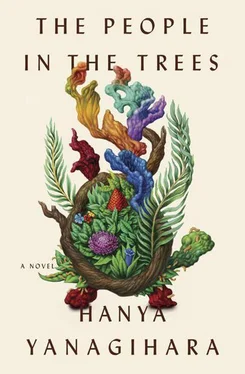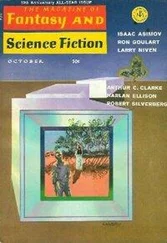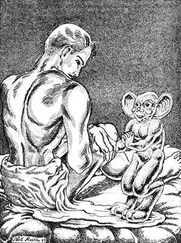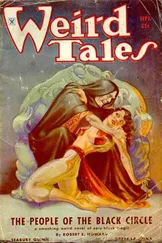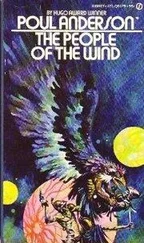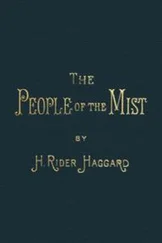With Uo I saw much of what had eluded me the last time, and since I was no longer as frightened, nor as anxious to reach our ultimate destination, I was able to examine everything more closely. And this time I did what I ought to have done when I had first had the opportunity: when Uo brought me a creature that I assumed was an armadillo but later saw was a monstrous beetle, its carapace jointed into a hundred flexible plates that rippled and shifted upon one another as it wriggled in his hands, I made drawings and took notes and measurements. I pressed between my notebook pages the round, gingkolike leaves that grew in staggered tiers on a spindly golden-trunked tree I’d not noticed before, the ones that changed color from green at their base to purple at their tips, the space in between filled by a strange, unnameable shade that made me think of dragons’ scales. I found a nest of plum-black lizard eggs the size of avocados whose stippled shells reminded me of leather and which peeled off in thick, supple pieces like an orange’s skin. (Inside, I was surprised to see the fetal lizards covered in a strange, cottony fuzz, one that began disintegrating as soon as the embryonic fluid was drained.) 64
Therefore, it was something of a disappointment when our journey was at last over and I was deposited by Uo among my own people at our camp. Tallent was not even there to greet me when I arrived. Instead there was only Esme, who I am sorry to say had not improved in appearance or temperament in the intervening seven years. She did not look pleased to see me.
“Norton,” she said.
“Esme,” I said. And that was it.
For all of Tallent’s fears about the island being overrun by various competitors and mercenaries, there was only one addition to our group, a minky little man named Johan Meyers, who was a mycologist from Berkeley. He was one of those people you meet and are instantly weary of, mostly because of his globular eyes and his rapid blink (he was very nearsighted) and his dreadful stammer, which was not helped by his insistence on narrating every small thing he encountered. I once made the mistake of going mushroom-hunting with him, and had to endure many hours of his dull prattle: “And now here we see — what is this? — oh, it’s a sort of fungus that grows in these stepped formations on this manama tree. Consistency very soft, almost velvety, tipped with what appears to be a very gentle fur, almost like that of a fly, but here powdery instead of coarse, and almost silvery in color,” etc., etc. Like most mycologists, Meyers was deeply boring and interested in only one thing: fungi. A dinosaur could have gone crashing through the forest inches before him and it’s doubtful he would have lifted his eyes from the puddle of snail-shaped mushrooms that he’d discovered growing at the base of a particularly mature lawa’a fern. He had absolutely no time for turtles or people, much less very old ones, and indeed had the useful ability to simply stop listening when the talk turned to such subjects, drifting off instead into a self-induced trance in which the whole world was remade as various fungal mutations. You always knew when this was happening, for his little mouth took on a sort of lightness and his eyes, behind their glass slabs, became moist and ecstatic. I often envied him those moments.
I hoped to accomplish three things while on my visit. The first was to gauge the chief’s mental health (he would be only sixty-seven, and his adviser seventy, and so this was more of a checkup than anything else; I wasn’t expecting any mental degradation yet). The second was to ascertain whether anyone else had celebrated their vaka’ina, and if so to begin a file on them. And the third — and primary — goal was to secure at least two opa’ivu’ekes, which I intended to take back alive to the States. I had a little less than a month to do this; on the twenty-eighth day, Uo would guide me back down-island, where I would be met by the boatman and taken back to U’ivu, where the pilot would meet me in the field at daybreak of the thirty-seventh day. If I missed him, I would have to wait until Tallent and Esme left the island, which would not be for another nine weeks after that.
One of the few nice things about revisiting a place that no one ever visits and where nothing ever changes is that one can skip all the introductions and reintroductions and simply reinsert oneself into the current of local life. By the fourth day, I had found the chief and had a brief audience with him. I am fairly certain he recognized me, but he seemed neither particularly surprised nor gratified by my presence. He did not seem to appreciate that I could now speak to him in his language, or the improbability of my reappearance in his life. But I did get from him the answer I wanted: no, no one else had celebrated their vaka’ina. As for the other question — that of his mental acuity — I had to make certain deductions. I could not, after all, give him any tests to measure it without offending him, but I left him feeling quite confident that no diminishment had yet begun.
The acquisition of opa’ivu’ekes was both more and less difficult than I’d anticipated. Happily, I did not have to go through the charade of pretending not to be interested in the turtle; without having to have an actual conversation about the matter, Tallent and I seemed to have reached some unspoken détente: he knew I was here for the opa’ivu’eke and had decided not to mention it if I did not. At any rate, I saw far less of him and Esme than I’d anticipated — their research was about the Ivu’ivuans’ family structure and society, things that did not much concern me, and they spent most of their days conducting interviews with the various villagers.
Less happy, however, was my lack of a guide to the lake of turtles. The one thing Tallent had forbidden me to do was ask any of the villagers how to find my way back up that winding path to the plateau; to do so, he told me, would cause such grave offense we’d be lucky to escape with our lives. In later years I would reflect on Tallent’s constant threats of the Ivu’ivuans’ violence and wonder how much of it was exaggerated to make me behave in a way that he thought I ought, and how much of it was real and based on actual experience. Certainly I knew from the way that I’d seen the villagers kill their catch that they were skilled with their spears and unafraid to use them, but I never, in all my time in the village, saw one man turn his weapon against another. Was it because there was no need to, or was it because they were fundamentally incapable of such brutality? I was never to know.
Naturally, I was not eager to make a stumbling, hapless nighttime exploration to the lake, and so I spent my days venturing farther and farther up the path, trying uselessly to remember what looked familiar and what did not. I began each journey by tying a string around the base of the manama tree behind the ninth hut and concluded each path by tying the other end of the string at its natural end. I had foolishly never considered that the path might prong off in so many directions, but the only thing that saved me from becoming completely frustrated was that each of the routes I unsuccessfully pursued had finished in a dead end: one against a glossy grove of yellow bamboo that was so tightly packed I couldn’t even squeeze my finger between them, another against a smooth blank edifice of putty-colored rock. Yet somewhere, somewhere high above me, was that snaking, illogical path that led to that improbable field and its lake with its gulping wide-eyed turtles. 65
Those were my days, then. But in the evenings I thought about the dreamers. It was difficult not to, especially when I was alone and in the forest; I kept expecting that one day I would turn and there, standing before that tree or slumped against that rock, one of them would be. Perhaps it would be someone I knew, one of the ones we had left with their god’s offerings of Spam and hunonos, or perhaps it would be one I had never seen before, a twin of Mua or Ika’ana. They might be single or in a group, sentient or not, terrifying in the moment or not. Sometimes in certain late-afternoon light, when the air around me seemed to shimmer and sag with millions of gold particles, I was almost certain that I saw one of them, a shadow of hair making a thundercloud against a curtain of trees, or heard one of their footfalls crunching the rug of dead leaves behind me. But when I looked, there was nothing, and I would have to remind myself that even if I did encounter one, I was fully capable of overpowering him, and that at any rate they would mean me no harm.
Читать дальше
